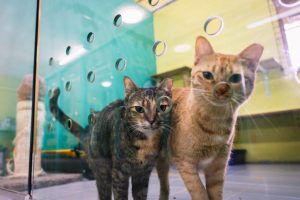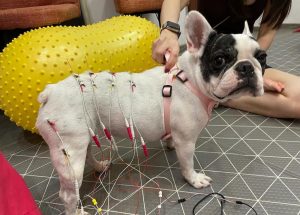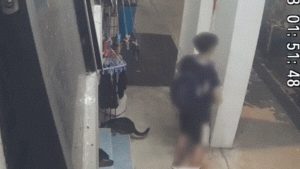Top image by the author
Every Tuesday night, Amelia* would make her way to a bus stop in Macpherson for a special dinner date. Without fail, a grey and white cat, one she’d been feeding since 2018, would be there. His name was Mattar—inspired by the nearby MRT station—though some feeders called him Matty or Africa.
But one day, in May this year, Mattar disappeared. Amelia, 47, put up notices at the Macpherson bus stop and made Facebook posts appealing for information on his whereabouts. Even if he was taken, just knowing he was safe and sound was enough, she wrote in one post.
ADVERTISEMENT
Despite her efforts—she and Mattar’s other feeders even appealed to the site lead of a nearby construction site to allow them to enter and look for him—the cat did not resurface.
It would be the fourth community cat disappearance she’d seen this year alone.
She’s nostalgic as she tells me all about Mattar, who showed up at the bus stop one rainy day, meowing unabashedly. “I think he was wet. That’s why he looked skinny.”
We’re at Meownistry of Meow, a co-working space where rescued cats are free to roam and interact with customers. Two particular cats, rescued from the vicinity of the construction site, stay here. She occasionally interrupts her own sentences to coo at them. But it’s clear that Mattar’s disappearance weighs on her. Not being able to see him is one thing. Not knowing where he is, or what’s become of him, breaks her heart, she says.
Community cats disappear for a variety of reasons—they can be vulnerable to snakes, stray dogs, and animal abusers, to name a few. But Mattar’s disappearance doesn’t sit right with Amelia.
“All I know is, four cats I had been helping look after have since disappeared,” says Amelia, who wants to remain anonymous in order to protect the ten or so other cats she cares for. “All four were located close to construction sites. And three were located at nearby bus stops.”
She doesn’t have any concrete evidence. But she asserts that the way the cats were all located near construction sites or bus stops, and all disappeared into thin air, is uncanny.
Amelia is part of a number of community feeders who suspect that cats are being trapped and relocated by pest control companies.
Cat Capers
Alessandro Lange, another community cat feeder, has had firsthand experience.
From 2020 to 2021, he was working in a foreign worker dormitory in Penjuru as a Covid-19 swabber. In his two years there, he was feeding close to 20 cats, as well as trapping, neutering, and releasing them. This is commonly referred to as TNR–it’s how the authorities, as well as animal welfare groups, keep the stray population here under control.
At the time, he only worked as temporary staff, and the dormitory’s full-time staff weren’t happy about his cat feeding habits.
“They would make complaints that I’m not allowed to feed the cats,” he remembers “They’d either say it’s ‘illegal’ or come up with excuses why I couldn’t feed the cats. Ultimately my intentions were to continue feeding just so I could gain the cats’ trust, sterilise them and rehome what I could.”
ADVERTISEMENT
One day, he showed up to work to find that almost all of the cats were gone. Only two evaded trapping.
After asking around, he found out the manager had called pest control on the cats as they were “causing a nuisance”. It was also mentioned to him that people were leaving food overnight, which attracted rodents.
“Funny thing is, it wasn’t me leaving the food overnight because I clean up. The cats weren’t killing any rodents because they were all well fed.”
Alarmed, he reached out to Cat Welfare Society (CWS), a charity which advocates for the safety and wellbeing of cats. They also act as a mediator for cat-related issues when needed. Luckily, the cats were with CWS as the charity had gotten wind of the situation and stepped in. Lange hadn’t managed to trap and neuter all the cats, so CWS was assisting with the sterilisation of the remaining ones.
After identifying himself as the cats’ community feeder, and assuring them he was in the process of securing boarding and new homes for the cats, CWS agreed to let the seven dormitory cats remain in Lange’s care.
Lange had been arranging for boarding before pest control came into the picture–he already felt it was getting dangerous for them to be around the dormitory. He was afraid the cats would be relocated and left unable to adjust to their new environs.
“What are the chances they would find their source of food, such as new feeders in a new environment? Would they hide in the drain, frozen in fear?”
The entire ordeal inspired the creation of his Facebook page Penjuru Rescued Cats, where he appealed for donations to cover the cats’ medical costs and boarding, which amounted to about $1,000 a month.
His second encounter with pest control took place in January 2022, when a friend, who regularly tended to a cat colony in an industrial building in Tuas, reached out with bad news.
The building manager had asked her to rehome the cats. But even before she could make arrangements, however, he went ahead to engage pest control to remove them.
The next thing Lange knew, four kittens were caught–the feeder called him, upset, telling him that pest control was about to take them away. So, he rushed down, retrieved the kittens, and drove off.
With the help of donations and social media appeals, the Penjuru and Tuas cases were eventually resolved. The cats found homes in the end, but it wasn’t easy on Lange or the other feeders.
ADVERTISEMENT
“It’s very distressing for feeders. Imagine feeding the same cats for a couple years, only to come to work, find them gone, and not know who took them away.”
Last-minute rescues, like the Tuas kittens, are also a strain on his resources, he adds.
“It could also be mentally draining. The amount of stress one goes through just to save a batch of kittens—you’re put in a position where you think, ‘Can I manage?’ I always have to consider every case before taking them on.”
Who’s To Blame?
There are some situations where the environment is genuinely unsafe for a cat—say, a building set to be demolished. But I gather from speaking to feeders that, more often than not, building or site managers find cats to be nuisances, and simply want them out of the compound.
It is not illegal to trap stray cats. But pest control companies are required to surrender such animals to the Animal & Veterinary Service (AVS), a unit within the National Parks Board (NParks).
Unfortunately, that’s not always what happens. CWS president Thenuga Vijakumar tells me that the charity has seen multiple cases or reports of suspected relocation of community animals.
“We have heard of areas in the east where [a pest control] van had been spotted,” she tells me, describing such vans as “dark coloured” with “cages at the back”. “Then all of a sudden, there are cats [in the area].”
The relocations might not be malicious. Vijakumar guesses that some of these pest control companies genuinely think dropping the animals off at a secondary location is better for them.
CWS even raised the matter to AVS earlier this year, says Vijakumar.
When RICE reached out to AVS, Dr Chang Siow Foong, its Group Director of Community Animal Management, confirmed that it had received feedback about pest control companies relocating cats instead of surrendering them.
AVS, together with its animal welfare group partners, currently manages the population of community cats through supporting sterilisation, under the Stray Cat Sterilisation Programme (SCSP), says Dr Chang.
CWS is the main entity carrying out the programme. Under the SCSP, NParks pays for half of a stray cat’s sterilisation, while CWS covers the other half with the help of donations.
“The release or relocation of cats outside the programme could disrupt the population dynamics at the sites,” says Dr Chang “It may lead to population increases due to breeding, and can compromise the welfare of the cats if they are removed from their regular caregivers.”
As such, AVS issued a circular to these companies in May 2023 that cats that are trapped or captured should be sent to AVS’ Animal Management Centre and not released or randomly relocated.
The circular seems to have had some impact in dampening cat trapping, at least. None of the pest control companies RICE contacted responded to our requests for comment. But when I posed as a potential client looking for cat trapping services, the responses were encouraging. Most flatly rejected me, and directed me to approach AVS, CWS, the Society for the Prevention of Cruelty (SPCA), or the Animals or Animal Concerns Research and Education Society (ACRES).
If you look hard enough, though, you’ll find pest control companies willing to trap cats for the right price.
When I reached out to one, pretending to be a contractor wanting to trap and remove a cat from a construction site, I was first directed to ACRES. The representative said ACRES’ services would be free and reasonably quick. But when I pressed the pest control company representative for a quote–telling him that my boss was in a hurry and wanted it–I was told, “Generally if it’s straightforward it’s $280.”
When I revealed that I was actually a reporter, however, he turned belligerent and refused to comment further.
Putting an End to the Vanishing Acts
It should be noted, however, that the pest control companies trapping cats are merely the symptom of an underlying issue—the abandonment and mistreatment of cats.
When building or site managers institute anti-cat policies–banning anyone from feeding these cats–or arranging for them to be trapped and removed, it only shifts more of the burden onto the shoulders of community cat feeders.
There’s virtually no area in Singapore with zero cats, Vijakumar says. “There is something called a vacuum effect, which dictates that when resources are available in the space, any animal that needs resources, they’re going to spread themselves wider. New cats are going to enter the vacuum.”
At the end of the day, relocating a cat elsewhere only shifts the burden of its care to another community feeder or caregiver. Maybe the area will be cat-free for a while, but another cat is going to move in eventually. Additionally, it can be upsetting for the original feeders if they aren’t kept in the loop about the cat’s move.
Vijakumar adds, “It is a disservice to both the cats who are freaked out, and to the [new] caregivers who are expected to look after them until the end of their life. Who’s contributing to medical costs? Who’s contributing to food costs? It’s really a very irresponsible shifting of the burden.”
Lange, a student who currently runs TNR initiatives for cats in industrial areas, also tells me that feeding bans simply cause more harm than good. Instead of driving the cats away, what ends up happening is that hungry cats start scavenging the building’s dustbins or walking into its canteens–causing more of a nuisance.
Controlled feeding in a safe area, on the other hand, ensures that cats don’t feel the need to enter places where they aren’t supposed to be.
The most logical solution, untenable as it may seem to cat haters, is to sterilise cats and manage them responsibly, rather than displacing them.
Rehoming should be the last resort, only if a location is truly unsafe.
“If someone is facing an issue, they should be able to reach out to us to discuss how to mitigate the situation, how to humanely manage it, and essentially have a long-term solution,” urges Vijakumar.
Some community cat feeders may think of pest control companies that trap cats as the enemy. A bogeyman preying on the helpless. But they’re simply the middlemen. Someone has to hire them. And it’s up to the decision-makers to take the most humane way out.
A day after I bid Amelia goodbye at Meownistry of Meow, I get an update from her. Another cat has gone missing.
A black cat named Blackie stares at me from a missing poster forwarded over WhatsApp. He used to hang out near a construction site around Tanjong Katong, as well as a nearby bus stop. It’s eerily similar to the four other cases she told me about. Just like those cases, she has no proof of trapping.
All she can do is hope for Blackie’s return.





